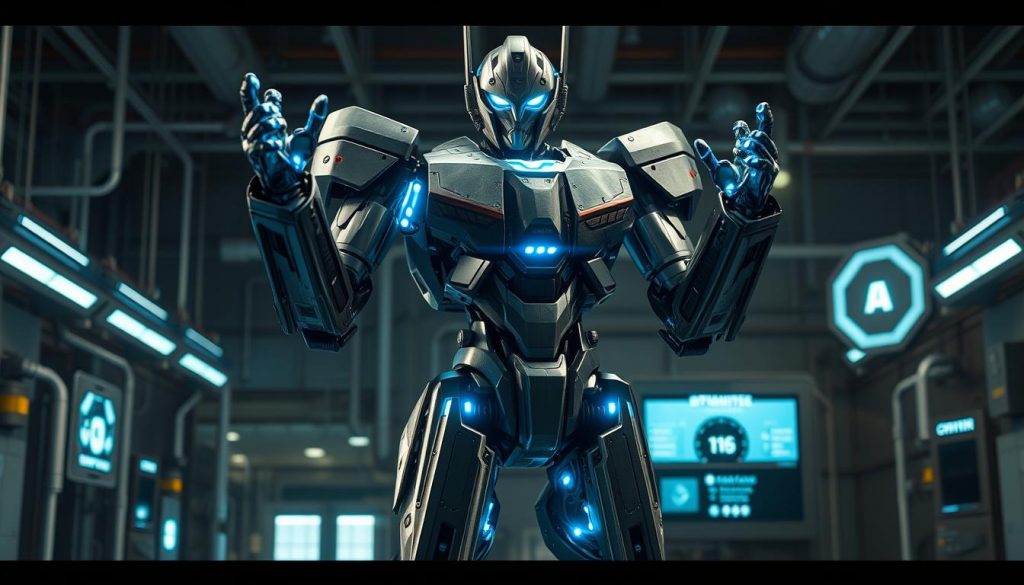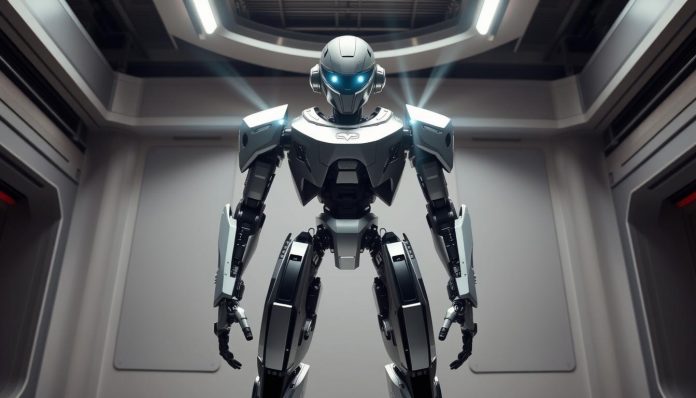Can a humanoid robot reshape a carmaker’s destiny and command most of its valuation? This article opens with that bold claim and asks what it means for the company, the market and the wider world.
He has framed a future where AI moves from software into physical products, linking a Master Plan to a strategy for sustainable abundance. The statement that roughly 80% of value could come from a robot project sits alongside softer vehicle deliveries and ambitious production targets.
This introduction previews the evidence and the questions to follow: the robot’s capabilities, the AI stack and compute bets, unit economics, and implications for UK manufacturing. It also flags the sceptical view that the plan may be promotional rather than concrete.
Read on for a balanced, data‑led assessment of whether robots can drive future growth, alter valuation models and transform manufacturing across the UK and beyond.
Key Takeaways
- The headline claim reframes the company from automaker to an AI‑first robotics firm.
- Master Plan rhetoric and an ~80% value assertion set the valuation narrative.
- Expect analysis of capabilities, roadmap, and the AI and compute strategy.
- Manufacturing impact matters to UK industry, from cost to labour substitution.
- The piece balances bullish projections with the sceptics’ concerns.
Introduction: A bold bet on humanoid robots reshaping Tesla’s future
A bold assertion that a robot programme could supply roughly 80% of corporate value has shifted strategic focus from vehicles to AI-driven hardware and services. This signals a deliberate turn in the master plan toward uniting software, mechatronics and scale compute.
The bold claim in context: “~80% of value”
The claim sits inside a wider communications strategy. It reframes a firm known for making cars as a potential platform company that sells hardware, models and recurring services to the wider world.
Trend analysis setup: from EV leader to AI and robotics platform
The narrative links autonomy, AI training and factory mechatronics to a new product and services mix. That shift matters to UK industry and other companies exploring productivity gains and novel business opportunities.
Why this matters now for UK readers and global watchers
With vehicle deliveries softening, the timing gives the robotics story traction in the market. The section that follows assesses technical feasibility, cost curves and the implications for growth across the world.
| Area | Immediate effect | UK relevance |
|---|---|---|
| Strategy | Shift from products to platform | Investment signals for suppliers |
| Manufacturing | Automation and labour substitution | Productivity and skills demand |
| Services | Recurring revenues from robot-enabled offerings | New service markets for firms |
Elon Musk’s statement and Master Plan Part 4: the pivot to “sustainable abundance”
A recent post placed a hard number on robotics’ share of corporate value:
“Those are the biggest factors. ~80% of Tesla’s value will be Optimus.”
musk said this in the context of Master Plan Part 4, which frames the group as bringing AI into the physical world and pursuing sustainable abundance.
The master plan language links autonomy, unified hardware and software, and a long‑term aim of broadening access to goods and services. That emphasis implies significant capital allocation to robot development and compute infrastructure rather than short‑term product tweaks.
Timing matters. Global vehicle deliveries fell 13% in the first half of the year, so the company’s stronger focus on humanoid robots reads as a fresh growth narrative. External robot deliveries are tentatively targeted for H2 2026, but specific timelines remain light.
What this means for investors and partners
- The explicit ~80% figure is notable because it is far more quantified than previous statements about robotics.
- Master Plan Part 4 mixes grand vision with few operational dates, raising questions about execution and information given to the market.
- The abundance framing suggests scaling autonomous systems to create new, recurring revenue streams over the long term.
Elon Musk Thinks Optimus Will Be Tesla’s Most Valuable Product: Find Out Why
Engineering logic now links the autonomy stack used in cars to a broader robotics agenda. The firm positions humanoid robots as another class of physical products that share perception, planning and actuation frameworks.
The platform approach creates a software and data flywheel. Learning from vehicles feeds robot models and vice versa. That cross‑domain training can raise system performance while lowering marginal development costs.
Why humanoid form factors matter: they work in human spaces without costly factory redesigns. The general‑purpose shape makes external launch and wider adoption simpler once reliability improves.
- Leverages decades of EV, battery and manufacturing know‑how to speed development.
- Starts with internal deployment to prove economics, then expands externally.
- Shifts KPIs from unit deliveries to utilisation, task completion and safety metrics.
| Focus | Near term | Strategic effect |
|---|---|---|
| Shared autonomy | Transfer algorithms | Faster development |
| Platform | Unified software | Compounding value |
| Deployment | Internal tasks | Proof of economics |
For more on the background to the reported valuation claim see reported valuation claim.
Optimus: capabilities today and the roadmap ahead
Initial capabilities centre on routine factory work, and the plan maps a path from internal proof to commercial launches.
Current roles on the shop floor
Prototypes are focused on simple, repetitive tasks such as staging and moving parts inside assembly areas.
Analysts at Piper Sandler expect these roles to expand across facilities within a year as reliability improves.
Near‑term milestones and a prospective launch
The roadmap emphasises proving safety and uptime in-house this year and next year.
If readiness criteria are met, an external launch is targeted for H2 2026 for early customers.
Unit economics and shift economics
Pricing models suggest a notional $100,000 per unit, equivalent to roughly £80k‑£100k depending on spec and exchange rates.
Machines capable of 18‑hour shifts could shorten payback periods and unlock meaningful labour substitution savings.
AI stack, FSD transfer and compute as investment
The autonomy stack borrows from vehicle software, using transfer learning from FSD to address locomotion and manipulation.
Compute is framed as an investment: heavy training spend is justified if lifetime robot economics and services revenue validate the potential.

“Early internal deployments generate the data loops needed to improve grasping, navigation and safety.”
- Internal scale first, then external deliveries if targets are met.
- Cost‑down levers: scale, standardised parts and software efficiency.
- Services—deployment, maintenance and upgrades—are key to long‑term returns.
Manufacturing technology implications: factories, automation and the future of work
Manufacturing floors face a new test as humanoid machines aim to sit alongside human teams without lengthy refits.
Latest manufacturing technology meets humanoid robots on the shop floor
Humanoid systems are designed to plug into existing lines. They contrast with fixed automation by offering flexibility for mixed‑model, high‑mix production common in UK plants.
That flexibility helps manufacturers avoid costly retooling when switching vehicle variants or introducing new products services bundles.
Manufacturing industry news context: cost, throughput and labour substitution
Robots working extended shifts can reduce takt‑time variability on repetitive tasks and improve output consistency.
Morgan Stanley’s estimate that around 10% of staff roles could be replaced illustrates potential labour cost savings and the need for reskilling technicians and operators.
- Throughput: stabilised by 24/7 operation on ergonomically challenging stations.
- Cost: total cost of ownership must include maintenance, spares and software licences.
- Workforce: transition planning is essential to manage reskilling and redeployment.
Safety, compliance and integration with UK/EU standards
Integration requires compliance with machinery directives and functional safety categories across the UK and EU.
Rigorous human‑robot interaction safeguards and traceability in MES and quality systems are non‑negotiable to pass audits and protect workers.
| Impact area | Benefit | UK relevance |
|---|---|---|
| Throughput | Reduced variability, higher yield | Supports growth in automotive and supplier lines |
| Energy | Better utilisation, fewer start‑stop losses | Improves plant efficiency and trade competitiveness |
| Platform integration | Data for continuous improvement | Matches UK factory MES and traceability needs |
Opportunities and risks sit side‑by‑side: flexible automation can boost resilience amid shifting trade patterns, but success hinges on reliability engineering, spare‑parts logistics and responsible workforce planning.
Market outlook, valuation narratives and AI technology news
Analyst models now layer robot deployments over traditional vehicle forecasts to test different value scenarios.
Piper Sandler projects prototype machines handling moving and staging tasks inside facilities by next year. Morgan Stanley models a c.10% workforce replacement, estimating about $2.5bn in annual labour savings if adoption scales.

Analyst takes and scenario sketches
Scenarios contrast upfront sales with platform and services revenue that compounds over time. One path emphasises immediate sales metrics; the other prioritises installed base, utilisation and subscription income.
CEO guidance on compute suggests heavy front‑loaded investment—claims of multi‑trillion revenue potential and large compute budgets imply early cash‑intensive phases before margins improve.
Implications for company valuation
Modelling shows valuation sensitivity to adoption speed and recurring income. If external sales scale slowly, market sentiment may hinge on clear milestone delivery and transparent communications under the master plan.
“Diversified revenue from robots can stabilise narratives when car sales soften,” said one analyst.
| Metric | Near term | Impact |
|---|---|---|
| Sales mix | Car→robot pilots | Alters revenue profile |
| Services | Recurring income | Higher lifetime value |
| Regulation | Procurement cycles | Year‑to‑year volatility |
The uncertainty: sceptics’ view, execution risks and open questions
Critics warn that grand visions often outpace the engineering and commercial steps needed to deliver them. Skeptical commentary highlights that master rhetoric about abundance reads as aspirational rather than operational for some observers.
Critiques, timelines and macro headwinds
Commentators note sparse dates and limited technical detail. They cite recent weak car sales in key regions and missed targets as added pressure on the plan.
Execution risks include achieving dextrous manipulation, robust perception in cluttered settings and scaling safety‑critical behaviours. Each remains a hard engineering problem.
“The narrative may rely on future compute and supply chains that are neither guaranteed nor cheap.”
- Dependence on frontier training compute and parts could delay timelines.
- Reputational risk rises if high‑visibility claims outstrip validated data.
- The company must balance investment between cars and new robotics without eroding core performance.
Open questions remain on service models, warranty terms and lifecycle costs that businesses will scrutinise before large purchases.
Conclusion: Elon Musk Thinks Optimus Will Be Tesla’s Most Valuable Product: Find Out Why
The closing argument weighs the bold valuation claim against practical engineering and market realities.
The thesis is clear: Elon Musk has placed robotics at the centre of the company’s future, linking the master plan to a shift from cars to AI‑driven products and services. That ambition explains why the plan has drawn intense market attention and sparked valuation debate.
Yet uncertainty remains. Technical hurdles, regulatory checks and macro headwinds mean progress must be demonstrated by measurable milestones, uptime and delivered value.
For UK manufacturers and policymakers the advice is pragmatic: track pilot deployments, align safety and compliance, and invest in skills so industry can capture productivity and growth from this transition.
Whether or not timelines match exactly what musk said, the move towards AI‑enabled robotics in factories is accelerating, and preparation is now essential.
For more articles on Artificial Intelligence, please follow the link


